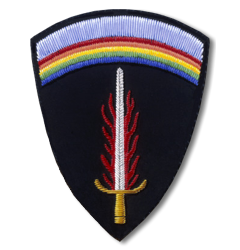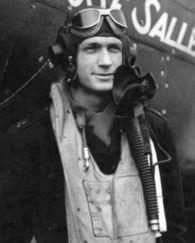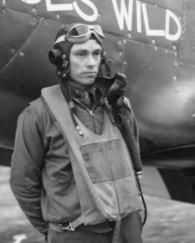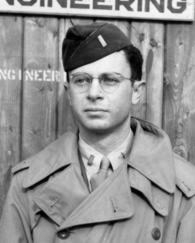The Supreme Allied Commander's flight with the Pioneer Mustang Group on the Fourth of July 1944
As we went to our planes, I watched General Eisenhower climb with some difficulty through the small opening behind the cockpit into the cramped bucket seat. There wasn't enough room for both him and a parachute, so the general flew without one. I watched his face as the crew chief buttoned down the Zeus fasteners on the Plexiglas window with a screwdriver, and if he had any misgivings about his obvious helplessness, he showed no concern.
I manned the brand-new Mustang, and started the engine. At the end of the runway General Quesada took off with his wingman in formation, and after a quick three-count I gave it the gas and followed with my wingman. Breaking ground, I pulled up the gear and started milking up the flaps. We caught the leading element within a mile of the strip, and settled into tactical combat formation on the general's right side. After we had climbed to 5000 feet, I made a visual post-take-off check of the cockpit, which I had neglected to do earlier, so preoccupied had I been with seeing that the other planes had gotten off safely. It was then I noticed that something was wrong. The oil-pressure gauge was stopped at zero, and not a quiver of the needle indicated any lubrication of the engine. I knew that without lubrication I had about five minutes' flying time before the engine would catch fire. I had visions of the horde of German fighters which would flock to the area at the first signs of flame, and I knew I had to get out of the area as quickly as possible. I didn't dare announce my departure over the RT, the Germans were constantly tuned in to our radio communications. In desperation I waved off my wingman and closed up to the general's plane. As I caught General Quesada's eye, I pointed at my engine nose and gave the cut engine hand signal. The general gave a quick nod, and without waiting for further acknowledgment I peeled away from the flight in a 180-degree turn. After leveling-off I shoved the nose down in a dive for the strip, cutting my rpm's to reduce the friction which must be building up terrific heat.
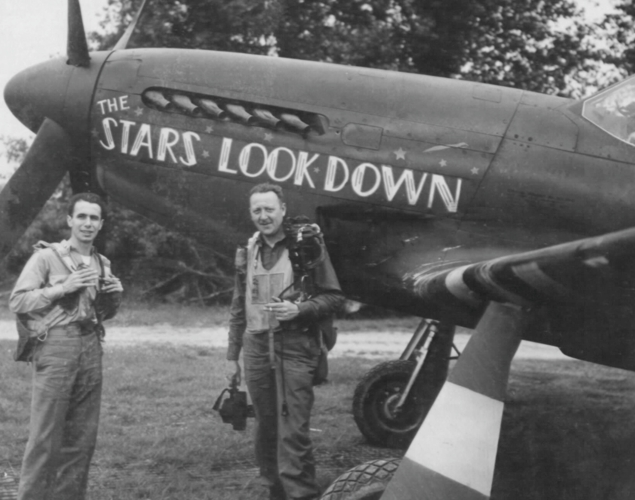
Capt. Wallace Emmer, 353rd FS and cameraman 1st Lt. A.R. Madsen stand by "The STARS LOOK DOWN", the P-51B Mustang fighter which carried the Supreme Commander of the Allied Forces over front lines. The Mustang was modified by the 461st Air Service Squadron with a "rumble seat" behind the pilot.
I hoped the others would not interpret my abrupt departure as a warning of attack, and wondered what I'd do if the engine packed up before I reached the strip. I was loath to damage a brand-new plane. The temperature gauge showed a quite normal reading, which surprised me since the oil-pressure needle still hung lifeless at zero. I saw the strip coming up and came straight into the runway under reduced power, cutting the throttle even before I touched down in an attempt to save the engine. Rolling to a stop hallway down the runway, I cut the switch and turned off the transmitter.
"He was so pleased with the mission that he could hardly wait to get back to his planning staff and start the gears grinding."
I climbed out of the plane as they came to tow it away, and walked to squadron operations to wait for a report on the aircraft. After a while Sergeant Belden came in looking very embarrassed. It seems that the new plane had been in perfect condition except for a disconnected pressure-sensing line which accounted for the zero reading I got on the oil gauge. Fortunately no real harm was done, and I told Sergeant Belden not to worry about the incident, sending him back to the line. Personally, I was very upset at having to leave the mission under such circumstances, and swore never again to fly any plane but my own.
Soon the recon flight returned, and I rushed out to the hardstand of the twin-seater. As I arrived General Eisenhower was being helped out of his cubbyhole with a wide grin on his face. He was so pleased with the mission that he could hardly wait to get back to his planning staff and start the gears grinding. I went up to General Quesada to apologize for my sudden departure and explain the reasons for it. The general, much to my relief, understood the dilemma, and approved of my action in the face of it. Although it was consoling to receive official sanction, I still felt a little foolish in light of the nature of the false alarm. But, of course, I had no way of determining this at the time.
This was the first time in history that a ground general had personally reconnoitered the terrain of a planned battle operation from a fighter aircraft in the presence of the enemy. Toward the end of July we took part in this operation which became known as "the breakthrough at Saint-Lo." In these operations General George S. Patton and his famed Third Army made the dramatic gains on enemy territory. Their advance was not halted until the supply line was weakened by distance before the defenses of Metz.

